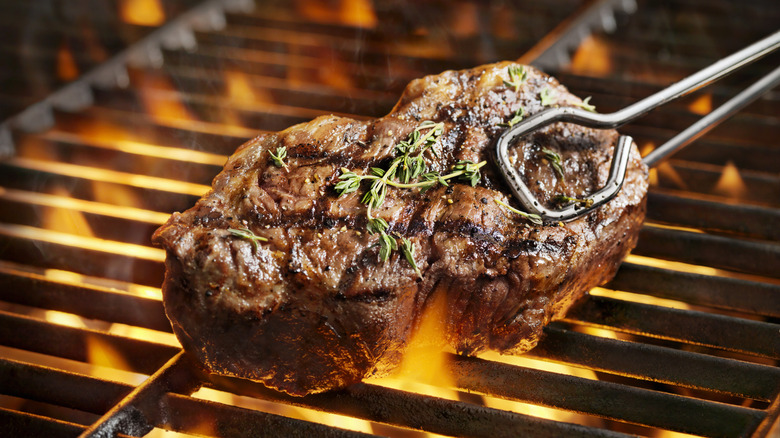Tom Colicchio's Favorite Way To Cook Steak Involves A Lot Of Flipping
Most people think treating steak gently is the best way to treasure it. Don't be too liberal when seasoning, never pound it too much, and certainly don't disturb it while it's cooking. The last tip is regarded as one of the biggest mistakes you're making with steak, but Tom Colicchio disagrees.
There are many contributing factors to a great steak — juiciness and delicious flavor, namely — but the one you'll first come in contact with is the crackly, browned surface. Simply put, this occurs when high heat touches sugars and amino acids in food, setting off a chemical reaction that brings out a richer taste. Many believe steak should be left alone to achieve this. In an interview with PopSugar, however, chef and steak aficionado Tom Colicchio refutes this maxim. Rather than flipping only once, he moves the steak up to six times, ensuring that each side and edge are seared properly.
For those in the "don't move that steak!" camp of grilling, constant motion pulls the steak away from the heat, stopping the browning process. But J. Kenji López-Alt proves that to be a myth. In an article penned for Serious Eats, he explains that the repeated movement of flipping allows the moisture from the steak to dry quickly, producing the same — if not better — crust of an undisturbed steak. Rotating it often also allows every inch of the steak to experience the high temperatures, resulting in more even cooking.
How to get the best sear when flipping steak often
While it pays to flip your steak often on the grill, not everyone is accustomed to the workings of the method. The main thing you need to know is that all steaks require the same conditions, whether you leave it undisturbed when cooking or not. To get your desired crust, the surface of the grill and steak should be completely dry. Moisture takes up all the heat's energy, focusing its efforts on evaporating the liquid rather than cooking the steak.
Once the meat has been patted dry, rub it down using oil with a high smoke point. This not only prevents it from sticking to the grates, but it also gives the steak a better sear. Flip the steak every 30 to 60 seconds. As you flip it, hit each corner and edge of the meat to ensure the entire surface develops an even crust. For the best results, use heat somewhere in between 450 to 500 degrees Fahrenheit. High heat is the key to setting off the Maillard reaction that gives food a deeper flavor.
All your efforts won't matter if you choose a poor piece of steak. It doesn't need to be the fanciest one out there, but get one with a suitable thickness. Anything less than around 1.25 inches thick will overcook, giving you a burnt, dry steak rather than a charred one.

